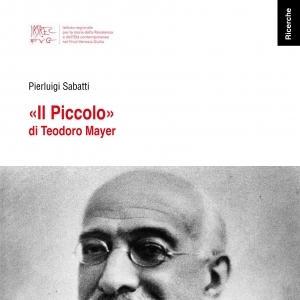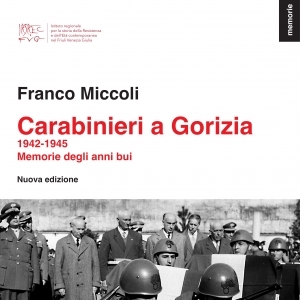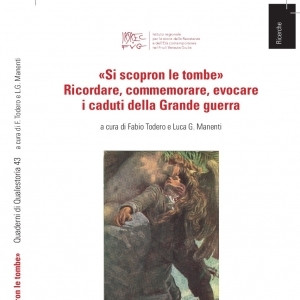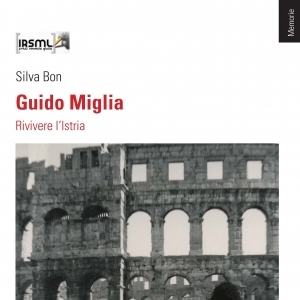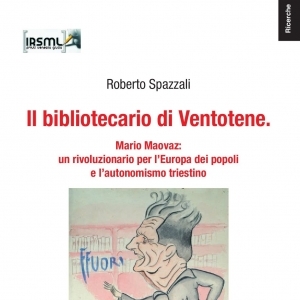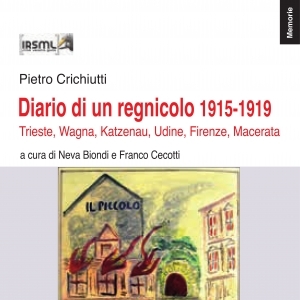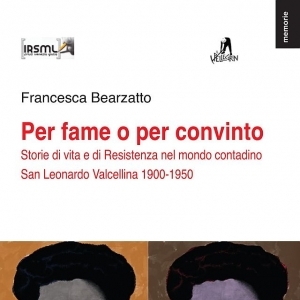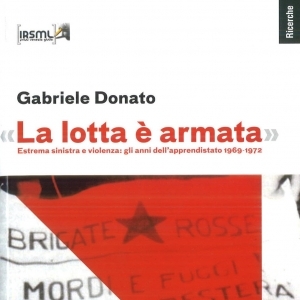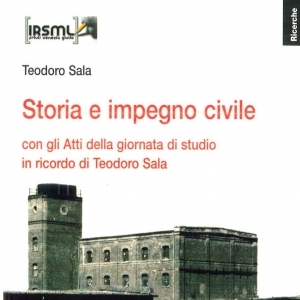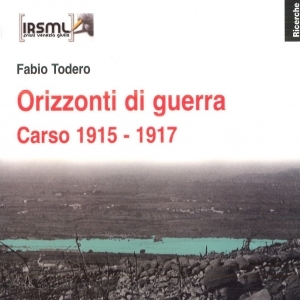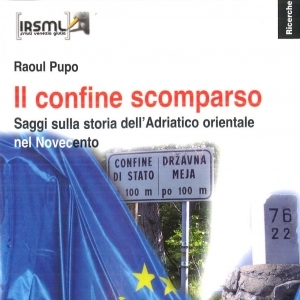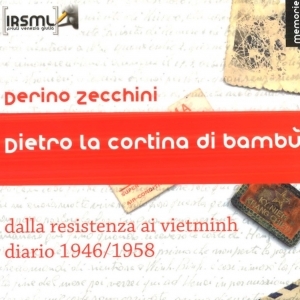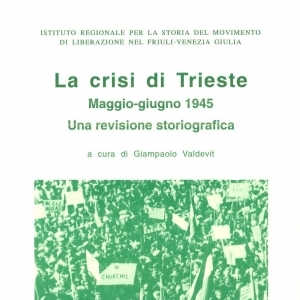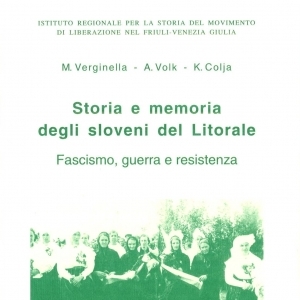Qualestoria 1/2021 - L’Italia e la Jugoslavia tra le due guerre
a cura di Stefano Santoro

Qualestoria, n. 1, giugno 2021, anno XLIX
L’Italia e la Jugoslavia tra le due guerre
a cura di Stefano Santoro
| Studi e ricerche Studies and researches |
||||
| Stefano Santoro | Alcune considerazioni sulle relazioni italo-jugoslave nel contesto danubianobalcanico durante il periodo interbellico Some considerations on Italian-Yugoslav relations in the Danube-Balkan context during the interwar period |
|||
| Massimo Bucarelli | Momenti e problemi della politica estera italiana verso la Jugoslavia tra le due guerre mondiali Remarks on Italian foreign policy towards Yugoslavia in the interwar period |
|||
| Alberto Becherelli | Italia e regno SHS nell’Europa di Versailles. Dispute confinarie e trame adriatiche nel nuovo equilibrio continentale Italy and the Kingdom of SHS in the Europe of Versailles. Border disputes and Adriatic plots in the new continental equilibrium |
|||
| Francesco Guida | La politica estera dell’Italia negli anni Venti, tra aspirazione all’egemonia nei Balcani e politica di pace obbligata. Un anno caldo per la Jugoslavia, il 1928 Italy’s foreign policy in the 1920s, between aspirations to hegemony in the Balkans and a policy of forced peace. A hot year for Yugoslavia, 1928 |
|||
| Jadranka Cergol | Le immagini dell’Altro nella letteratura triestina slovena e italiana del periodo interbellico The images of the Other in the Slovenian and Italian literature of interwar Trieste |
|||
| Alberto Basciani | Struggle for supremacy in Adriatic. Italy, SHS Kingdom and the Albanian question |
|||
| Antonella Fiorio | Tra Italia e Jugoslavia: la Dalmazia e la difficile applicazione del trattato di Rapallo Between Italy and Yugoslavia: Dalmatia and the hard enforcement of the Treaty of Rapallo |
|||
| Maciej Czerwiński | Culture, arts, politics. Italy in Ivan Meštrović’s and Bogdan Radica’s discourses between the two World Wars |
|||
| Srđan Mićić | Vojislav Marinković and Italy, 1927- 1932 |
|||
| Stipica Grgić | Italy and Yugoslavia on the football pitch 1925-1939 |
|||
| Ciano, Stojadinović e il riavvicinamento italo-jugoslavo | ||||
| Federico Imperato | Galeazzo Ciano ministro degli Esteri e la Jugoslavia (1936-1939) The Italian Foreign Minister, Galeazzo Ciano, and Yugoslavia (1936-1939) |
|||
| Dragan Bakić | Mussolini of Yugoslavia? The Milan Stojadinović regime and the impact of Italian fascism, 1937-1939 |
|||
| Bojan Simić | Milan Stojadinović and Italian-Yugoslav relations (1935-1941) |
|||
| Documenti e problemi Records and issues |
||||
| Andrea Dessardo | Una vicenda dimenticata, ma riemersa dagli archivi: le dimissioni del commissario generale civile per la Venezia Giulia Augusto Ciuffelli A forgotten event re-emerged from the archives: The resignation of the Civilian General Commissioner for the Julian March Augusto Ciuffelli |
|||
| Andrea Scartabellati | Una testimonianza sulla cattura di Natale Kolarič (maggio 1944) da un documento del 1975 dell’archivio di Marija Bernetič A testimony on the capture of Natale Kolaric (May 1944) from a document of Marija Bernetic’s archive |
|||
| Lorenzo Ielen | «Prigionieri della libertà»: i profughi stranieri nelle pagine del «Giornale di Trieste» «Prisoners of freedom»: the foreign refugees in the pages of the «Giornale di Trieste» |
|||
| Arte e politica | ||||
| Maurizio Lorber | «Marameo! Giornale politico satirico pupazzettato» (1919-1942). Critica d’arte e politica nello sberleffo ideologico «Marameo! Giornale politico satirico pupazzettato» (1919-1942). Art criticism and politics in ideological mockery |
|||
| Lorenzo Nuovo | I pittori e il trattato di Rapallo: il caso di Figura con pipa di Gino Parin Painters and the Treaty of Rapallo: the case of Gino Parin’s Figura con pipa |
|||
| Renzo Villa | Plastica muratoria: episodi monumentali massonici nell’Italia liberale Monumental Freemasonry episodes in liberal Italy |
|||
| Messa a fuoco: la parola agli storici Focus: historians speaking |
||||
| Giornalismo di guerra Intervengono Mauro Forno, Lorenzo Benadusi, Enrico Serventi Longhi |
||||
| Note critiche Reviews |
||||
| Jacopo Bassi | Richard Clogg, Greek to me. A Memoir of Academic Life, I.B. Tauris, London 2018 |
|||
| Anna Di Gianantonio | Gian Luigi Bettoli, A dispetto della dittatura fascista. La lunga resistenza di un movimento operaio di frontiera: il Friuli dal primo al secondo dopoguerra, Olmis, Osoppo 2019 |
|||
| Anna Di Gianantonio | Marcello Flores, Cattiva Memoria. Perché è difficile fare i conti con la storia, il Mulino, Bologna 2020 |
|||
| Marco Labbate | Massimo Baioni, Vedere per credere. Il racconto museale dell’Italia unita, Viella, Roma 2020 |
|||
| Luca G. Manenti | Giovanni Bernardini, Parigi 1919. La Conferenza di pace, il Mulino, Bologna 2019 |
|||
| Luca G. Manenti | Filippo Focardi, Nel cantiere della memoria. Fascismo, Resistenza, Shoah, Foibe, Viella, Roma 2020 |
|||
| Alessio Marzi | Christian Goeschel, Mussolini e Hitler. Storia di una relazione pericolosa, Laterza, Bari-Roma 2019 |
|||
| Livio Sirovich | Medicina e Shoah. Eugenetica e razzismo del Novecento. Parentesi chiusa o problema aperto? a c. di Federica Scrimin, Tristano Matta, EUT, Trieste 2020 |
|||
| Livio Sirovich | Peter Sedgman, Per quanto posso ricordare, con un intervento di Michael Evans, edizione italiana a c. di Tristano Matta, Battello Stampatore, Trieste 2020 |
|||
| Fabio Verardo | Andrea Corsiglia, Come si costruisce una dittatura. La politica giudiziaria del Tribunale speciale e il caso savonese del marzo 1934, Il Nuovo Melangolo, Genova 2020 |
|||
Gli autori di questo numero
Dragan Bakić è senior research associate all’Institute for Balkan Studies della
Serbian Academy of Sciences and Arts. I suoi principali interessi di ricerca riguardano
la storia della Serbia, della Jugoslavia e dei Balcani nell’epoca delle guerre
mondiali, specialmente la politica estera e di sicurezza, oltre alla politica estera
britannica verso l’Europa danubiana. Recentemente, ha studiato la politica della
destra serba all’interno di un progetto, di cui è principal investigator, intitolato The
Serbian Right-Wing Parties and Intellectuals in the Kingdom of Yugoslavia, 1934-
1941, finanziato dal Fondo per la ricerca scientifica della Repubblica di Serbia. Fra
le sue pubblicazioni: Britain and Interwar Danubian Europe: Foreign Policy and
Security Challenges, 1919-1936 (Bloomsbury, 2017); The Italo-Yugoslav Conflict
over Albania: a View from Belgrade, 1919-1939 («Diplomacy & Statecraft», 2014);
The Serbian Minister in London, Mateja Bošković, the Yugoslav Committee, and
Serbia’s Yugoslav Policy in the Great War, 1914-1916 («Balcanica», 2019).
Alberto Basciani è professore associato di Storia dell’Europa orientale presso
l’Università Roma Tre. I suoi interessi di ricerca prevalenti riguardano l’evoluzione
politica e le dinamiche modernizzatrici del Sud-est d’Europa negli anni tra le due
guerre mondiali. Tra le sue più recenti pubblicazioni si segnalano le monografie:
L’illusione della modernità. Il Sud-est dell’Europa tra le due guerre mondiali (Rubbettino,
2016), Dificila unire. Basarabia și România Mare, 1918-1940 (Editura
Cartier, 2018) (ed. italiana 2007) e, infine, con Egidio Ivetic, Italia e Balcani. Storia
di una prossimità (il Mulino, 2021). Recentemente ha curato la pubblicazione del
numero monografico Dopo la Grande guerra. Violenza, stati e società tra Adriatico
orientale e Balcani («Qualestoria», 2020).
Alberto Becherelli ha conseguito il dottorato di ricerca in Storia dell’Europa
presso l’Università di Roma “La Sapienza”. Presso il medesimo ateneo è stato assegnista
di ricerca nell’ambito del progetto FIRB 2010 L’Europa di Versailles (1919-
1939). I nuovi equilibri europei tra le due guerre nelle fonti dell’Archivio dell’Ufficio
Storico dello Stato Maggiore dell’Esercito. Si occupa di temi relativi ai rapporti
tra l’Italia e l’Europa danubiano-balcanica, con particolare attenzione all’area ex jugoslava
durante il periodo interbellico e la Seconda guerra mondiale. Ha pubblicato
le seguenti monografie: Il Regno dei Serbi, Croati e Sloveni nell’Europa di Versailles
(1918-1921) (Aracne, 2017); (con P. Formiconi) La quinta sponda: una storia
dell’occupazione italiana della Croazia: 1941-1943 (Stato Maggiore della Difesa,
2015); Italia e Stato Indipendente Croato 1941-1943 (Nuova cultura, 2012).
Massimo Bucarelli insegna Storia delle Relazioni Internazionali presso il Dipartimento
di Metodi e Modelli per l’Economia, il Territorio e la Finanza, dell’Università
di Roma “La Sapienza”. Ha pubblicato saggi, monografie e opere collettanee,
su alcuni aspetti e problemi della politica estera italiana verso il Mediterraneo e i
Balcani nel Novecento. Sulle relazioni italo-jugoslave tra le due guerre mondiali,
oltre alla monografia Mussolini e la Jugoslavia 1922-1939 (B. A. Graphis, 2006),
ha recentemente pubblicato: Mussolini and the Yugoslav Question during the First
World War, in Serbia And Italy In The Great War, ed. V.G. Pavlović (Institute for
Balkan Studies, Serbian Academy of Sciences and Arts, 2019); An Unavoidable
Conflict? The Italian-Yugoslav Confrontation in the Adriatic Sea and the Balkans,
in The “Jewish Question” in the Territories Occupied by Italians 1939-1943, eds.
G. Orsina, A. Ungari (Viella, 2019).
Jadranka Cergol è professore associato presso il Dipartimento di italianistica
della Facoltà di Studi Umanistici di Capodistria, dove insegna alcune materie linguistiche
e letterarie al primo e secondo livello di studi. Dal 2020 è anche direttrice
dell’Istituto di studi interculturali della Facoltà. Pubblica soprattutto contributi
nell’ambito linguistico e letterario, attinenti da una parte alla lingua e cultura grecoromana
e umanistica e dall’altra all’ambito della letteratura minoritaria e regionale.
In particolare si interessa di questioni riguardanti l’identità etnica nella letteratura
regionale e minoritaria, concentrandosi principalmente sull’area dell’Alto Adriatico.
Fra le sue pubblicazioni: Med mero in misterijem: antični svet v delih Alojza
Rebule (Mladika, 2012); Il popolo etrusco e i poeti augustei: i casi di Properzio
e Orazio («Atene e Roma», 2019); Some Typological Features of ‘Minority’ Literature:
the Case of the Slovenian and Italian Minorities («L’analisi linguistica e
letteraria», 2016).
Maciej Czerwiński è professore universitario di Lingue e Letteratura, slavista
e traduttore, autore di circa 150 pubblicazioni, incluse sette monografie. È stato
visiting assistant alla Yale University e fellow all’Imre Kertész Kolleg (Jena). Si
occupa di lingue, letterature e culture della Slavia meridionale nel XX secolo in una
prospettiva semiotica e storica. Le sue recenti pubblicazioni riguardano la questione
dell’immaginario letterario della seconda guerra mondiale nella prosa narrativa
croata e serba e il tema del regionalismo croato, con particolare attenzione per le
terre di confine dalmate. È autore di una sintesi divulgativo-scientifica della storia
croata in polacco. Attualmente è direttore del Dipartimento di Filologia Slava della
Jagiellonian University di Cracovia. Fra le sue pubblicazioni: Chorwacja. Dzieje,
kultura, idee (Międzynarodowe Centrum Kultury, 2020); Drugi svjetski rat u hrvatskoj
i srpskoj prozi (Hrvatska sveučilišna naklada, 2018); Old Dubrovnik, Young
Serbia and Vague Croatia. Mental Maps in the Serb-Catholic Imagination in Dubrovnik
(«Acta Poloniae Historica», 2020).
Antonella Fiorio è dottoranda in Scienze delle Relazioni Umane presso l’Università
di Bari, dove studia la politica estera italiana nell’Europa danubiana tra le
guerre mondiali. Si occupa anche di Public History e Digital Humanities. Tra le sue
ultime pubblicazioni: con C. Calefati, F. Palmieri, Storia e fake news: il caso del
neoborbonismo («Ricerche di Storia Politica», 2020); con C. Calefati, F. Palmieri,
Brigantiland. Social media, circuiti commerciali, intrattenimento («Meridiana»,
2020); con V. Saracino, Così vicini, così lontani. La prossimità italo-albanese dalle
origini del secolo breve alla Resistenza (Besa, 2020).
Stipica Grgić è research associate al Dipartimento di Storia Contemporanea del
Croatian Institute of History (Zagabria). Attualmente si interessa allo studio di temi
legati alla storia politica, sociale e quotidiana della Croazia e delle nazioni confinanti
nei primi quattro decenni del XX secolo. Fra le sue pubblicazioni: The Kingdom
of Diversity and Paternalism: the Kingdom of Serbs, Croats, and Slovenes/
Yugoslavia, 1918-1941, in Interwar East Central Europe, 1918-1941: The Failure
of Democracy-building, the Fate of Minorities, ed. S.P. Ramet (Routledge, 2020);
Pantheon on a tablecloth: Yugoslav dictatorship and the confrontation of national
symbols in Croatia (1929-1935) («Nationalities Papers: The Journal of Nationalism
and Ethnicity», 2018).
Francesco Guida è professore ordinario di Storia dell’Europa centro-orientale
all’Università Roma Tre. Per la sua attività scientifica ha ottenuto due volte all’estero
il titolo di doctor h. c. e alcune onorificenze. Componente del Consiglio Universitario
Nazionale, è vicepresidente della Conferenza Italiana di Scienze Politiche (CISPOL).
Presiede l’Associazione italiana di Studi del Sud-Est europeo (AISSEE),
l’Associazione italiana Studi di Storia dell’Europa centrale e orientale (AISSECO),
il Centro Interuniversitario Studi ungheresi e dell’Europa centro-orientale (CISUECO).
È vicepresidente dell’Association Internationale d’Études du Sud-Est Européen.
Membro di altre associazioni scientifiche e del Comitato scientifico di alcune
riviste straniere di storia, è referee di Enti di ricerca e riviste in Italia e all’estero.
Ha pubblicato 11 libri e oltre 190 saggi su temi storici. È stato curatore di 30 volumi
miscellanei. Opere recenti: La Russia e l’Europa centro-orientale 1815-1914 (Carocci,
2006); Romania (Unicopli, 2009); L’altra metà dell’Europa. Dalla Grande
Guerra ai giorni nostri (Laterza, 2015).
Federico Imperato è uno studioso di Storia delle Relazioni Internazionali, disciplina
in cui ha conseguito l’abilitazione a professore associato e di cui è cultore
presso il Dipartimento di Scienze Politiche dell’Università degli Studi di Bari
“Aldo Moro”. È autore di numerosi saggi e articoli sulla politica estera italiana, tra
cui si ricordano le seguenti monografie: Aldo Moro e la pace nella sicurezza. La
politica estera del centro-sinistra 1963-1968 (Progedit, 2011), Aldo Moro, l’Italia e
la diplomazia multilaterale. Momenti e problemi (Besa, 2013) e La «chiave dell’Adriatico».
Antonio Salandra, Gaetano Salvemini, la Puglia e la politica balcanica
dell’Italia liberale durante la Grande Guerra (1914-1918) (Rubbettino, 2019).
Srđan Mićić è research associate all’Institute for Recent History of Serbia. Il
campo principale delle sue ricerche è la politica estera, la diplomazia formale ed informale,
il servizio diplomatico-consolare e la propaganda del Regno di Jugoslavia
durante il periodo interbellico. In particolare, si occupa delle relazioni bilaterali e
multilaterali fra Jugoslavia, stati balcanici e centro-europei e potenze europee. Questa
ricerca è stata recentemente allargata alla diplomazia multilaterale jugoslava nel
contesto delle attività della Società delle Nazioni. Fra le sue pubblicazioni: Influence
of France and Italy’s (Central) European projects on Yugoslavia’s re-evaluation
of regional pacts («Istorija XX veka», 2020); К.Ст. Павловић, Дневник 1932-
1932, прир. С. Мићић, Н. Милићевић [K.St. Pavlović, Diario 1930–1932, a. c.
di S. Mićić, N. Milićević)] (IAB-INIS, 2020); Од бирократије до дипломатије:
историја југословенске дипломатске службе 1918–1939 [Dalla burocrazia alla
diplomazia: la storia del servizio diplomatico jugoslavo 1918–1939] (INIS, 2018).
Stefano Santoro è ricercatore in Storia dell’Europa orientale all’Università di
Trieste, con abilitazione a professore associato. Le sue ricerche si sono orientate
principalmente sulle relazioni politiche e culturali fra Italia ed Europa orientale nel
Novecento, con particolare riguardo per il campo della cultura e della propaganda
nel periodo interbellico, e sul nazionalismo romeno fra Otto e Novecento, con un
focus sul caso della Transilvania. Fra le sue pubblicazioni, oltre a numerosi saggi
apparsi in Italia e all’estero, i volumi L’Italia e l’Europa orientale. Diplomazia culturale
e propaganda 1918-1943 (FrancoAngeli, 2005), Dall’Impero asburgico alla
Grande Romania. Il nazionalismo romeno di Transilvania fra Ottocento e Novecento
(FrancoAngeli, 2014) e la curatela, con F. Zavatti, di Clio nei socialismi reali.
Il mestiere di storico nei regimi comunisti dell’Europa orientale (Unicopli, 2020).
Bojan Simić è senior research fellow all’Institute for Recent History of Serbia.
Ha discusso la sua tesi di dottorato alla Scuola Normale Superiore di Pisa (2011). I
suoi interessi di ricerca riguardano la politica estera della Jugoslavia, la propaganda
statale in Europa orientale e meridionale, la storia dei media. Fra le sue pubblicazioni:
Milan Stojadinović i Italija. Između diplomatije i propagande (Institut za
noviju istoriju Srbije, 2019), Държавната пропаганда в Югославия и България
през 30-те години на ХХ век [Propaganda di stato in Jugoslavia e Bulgaria negli
anni Trenta] (IK Gutenberg, 2020), Jugoslavija i Argentina 1946-1955 (Institut za
noviju istoriju Srbije, 2021), oltre a numerosi articoli scientifici.
Studi e ricerche
Studies and researches
Alcune considerazioni sulle relazioni italo-jugoslave nel contesto danubiano-
balcanico durante il periodo interbellico
Some considerations on Italian-Yugoslav relations in the Danube-Balkan context
during the interwar period
di Stefano Santoro
This article aims to present the contents of this monographic issue and to expose some
considerations on Italian-Yugoslav relations during the interwar period, in the framework
of Italian strategies towards the Danube-Balkan region. For this purpose, some
constants in the Italian eastwards projection and great power ambitions, between the
last post-WWI liberal governments and the fascist regime, will be highlighted. Space
will be dedicated to the role played by cultural circles and political propaganda, which
represented crucial elements in order to support Italian hegemonic projects towards both
Yugoslavia and the whole central and south-eastern European area.
Keywords: Italy, Yugoslavia, Danube-Balkan region, Culture, Propaganda
Parole chiave: Italia, Jugoslavia, Regione danubiano-balcanica, Cultura, Propaganda
Momenti e problemi della politica estera italiana verso la Jugoslavia tra
le due guerre mondiali
Remarks on Italian foreign policy towards Yugoslavia in the interwar period
di Massimo Bucarelli
Relations between Italy and Yugoslavia in the interwar period were generally tense, uncooperative
and unfriendly. A number of political problems opened up a great rift between
Rome and Belgrade: the diplomatic struggle for possession of Istria, Fiume and
Dalmatia; the political rivalry for control of Albania; the Italian support for Croatian
and Macedonian separatism; and the presence of national minorities within the respective
borders. This paper, based on the most relevant and recent scholarly works on Italian-
Yugoslav relations, seeks to offer a reassessment of the complexity of Italy’s foreign
policy towards Yugoslavia between the two world wars.
Keywords: Italian-Yugoslav Relations, Adriatic Question, Fascist Foreign Policy towards
the Balkans, Italian Support for anti-Yugoslav Separatism, Yugoslav Foreign Policy
Parole chiave: Relazioni italo-jugoslave, Questione adriatica, Politica estera fascista nei
Balcani, Sostegno italiano al separatismo anti-jugoslavo, Politica estera jugoslava
Italia e regno SHS nell’Europa di Versailles. Dispute confinarie e trame
adriatiche nel nuovo equilibrio continentale
Italy and the Kingdom of SHS in the Europe of Versailles. Border disputes and
Adriatic plots in the new continental equilibrium
di Alberto Becherelli
The Adriatic issue was one of the most difficult and dangerous questions for the peace
building in Europe: after the armistice, Italy and the recently proclaimed Kingdom of
Serbs, Croats and Slovenes were strongly resolute in gaining their conflicting territorial
claims and tension escalated to the point that an armed conflict was a serious risk.
The Adriatic issue, however, did not concern only Rome and Belgrade, but it generally
involved the economic interests and stability of the entire Central-Eastern Europe. Despite
internal rivalries between Yugoslav nationalities, the Kingdom of SHS was one of
the backbones of the new political and territorial order in the Danube-Balkan region,
where the hegemonic purposes of France and Great Britain had to face the ambitions of
new powers such as Italy.
Keywords: Italo-Yugoslav relations, Italo-French disputes, Adriatic issue, Danube-Balkan
region, Little Entente
Parole chiave: Relazioni italo-jugoslave, Dispute italo-francesi, Questione adriatica, Europa
danubiano-balcanica, Piccola intesa
La politica estera dell’Italia negli anni Venti, tra aspirazione all’egemonia
nei Balcani e politica di pace obbligata. Un anno caldo per la Jugoslavia,
il 1928
Italy’s foreign policy in the 1920s, between aspirations to hegemony in the Balkans
and a policy of forced peace. A hot year for Yugoslavia, 1928
di Francesco Guida
In the first part, the essay provides a general overview of Italian foreign policy towards
Southeastern Europe in the 1920s. In its second and more detailed part, it deals with the
year 1928, which was particularly troubled in the Balkans and mainly in Yugoslavia, and
with the political and diplomatic initiatives implemented by Rome towards the area and
in particular towards the SHS Kingdom. The study highlights some of the uncertainties
of this policy (e.g., regarding the support given to the Croatian and Macedonian national
movements) that stemmed from the opinions of Mussolini, but also of Dino Grandi, undersecretary
at the Ministry of Foreign Affairs, and from those of the network of Italian
diplomats in the Balkan capitals. Particularly significant information and suggestions
came from Minister Galli, the Italian representative in Belgrade.
Keywords: Italia, Balcani, Jugoslavia, anni Venti, pace
Parole chiave: Italy, Balkans, Yugoslavia, 1920s, peace
Le immagini dell’Altro nella letteratura triestina slovena e italiana del
periodo interbellico
The images of the Other in the Slovenian and Italian literature of interwar Trieste
di Jadranka Cergol
Using the methodology of frontier imagology that presents itself as the most appropriate
tool for critically analyzing the reciprocal representations of human communities, we will
try to present the image of Italians that is reflected in the works of Slovenian literature
by comparing them with images of Slovenes in Italian literature. The research will focus
in particular on the period between the two wars, although in some cases the discourse
will also be extended to the pre-war period to highlight the changes in perception from
the time in which Trieste was part of the Austro-Hungarian Empire to the Fascist period.
Keywords: Frontier imagology, Mirror images, Border literature, Trieste, Slovenians in Italy
Parole chiave: Imagologia di frontiera, Immagini speculari, Letteratura di confine, Trieste,
Sloveni in Italia
Struggle for supremacy in Adriatic. Italy, SHS Kingdom and the Albanian
question
di Alberto Basciani
The challenge for the predominance in Albania and, therefore, in the lower Adriatic was
the other (less known) aspect of the Italian-Yugoslavian rivalry that arose after the First
World War. The article analyzes the stages that, from the Paris negotiations to the Treaty
of Tirana of 2 November 1927, characterized the harsh political and diplomatic confrontation
between Rome and Belgrade, resolved by the superior economic means available
to Italy’s ambitions and by King Zog’s desire to have a munificent protector who was,
however, geographically at a safe distance.
Keywords: Italian expansionism, Albania, Kingdom SHS, National Bank of Albania
Parole chiave: Espansionismo italiano, Albania, Regno SHS, Banca nazionale d’Albania
Tra Italia e Jugoslavia: la Dalmazia e la difficile applicazione del trattato
di Rapallo
Between Italy and Yugoslavia: Dalmatia and the hard enforcement of the Treaty of
Rapallo
di Antonella Fiorio
After the First World War, the dissolution of the Austro-Hungarian Empire was followed
by moments of confusion related to the definition of the new order of the Danube-Balkan
area of Europe. The establishment of the Kingdom of the Serbs, Croats and Slovenes led
to geographical and socio-cultural problems; therefore, Dalmatia is an interesting case
study. Militarily occupied in its central-northern area by Italy on the basis of the London
Pact (1915), Dalmatia soon became a battleground between the Kingdom of Italy and the
Kingdom of SHS, fragmenting externally as well as internally between adherents to the
Yugoslavian structure and those opting for the Italian proposal. Article VII of the Rapallo
Treaty of 12 November 1920 established the possibility for minorities living in Yugoslavian
territory to take Italian citizenship. This was not an easy choice.
The proposed essay starts from this complex framework as a starting point to illustrate
and understand the drama experienced by the Italian communities of Dalmatia in the
interwar period. The treaty of Rapallo itself that for the liberal government represented
the end of the disputes and the hope for a rapprochement of the communities, for the
Italians of Yugoslav Dalmatia it was instead the beginning of abandonment and the end
of irredentism. The 1921 agreements of Split gave way to the liberation of the occupied
Yugoslav territory, with the consequent exodus of part of the Italian communities settled
there. The essay will shed light on the difficult position in which the Italian Dalmatian
political leaders found themselves and how they reacted to the coming of Mussolini with
the ratification of the Santa Margherita agreements (1923), the treaties of Rome (1924)
and the conventions of Neptune (1925), crossing the micro-history of the Italian communities
of Dalmatia with the history of fascist Italy up to the tragic involvement in the
Second World War.
Keywords: Italo-Yugoslav relations, Treaty of Rapallo, Dalmatia, Minorities, Italians
Parole chiave: Rapporti italo-jugoslavi, Trattato di Rapallo, Dalmazia, Minoranze, Italiani
Culture, arts, politics. Italy in Ivan Meštrović’s and Bogdan Radica’s
discourses between the two World Wars
di Maciej Czerwiński
In this article the activity and discourses of two Dalmatian public figures are taken into
consideration: the sculptor Ivan Meštrović and the journalist Bogdan Radica. They both
had an enormous influence on how the image of Italy was created and disseminated
in Yugoslavia, in particular in the 1920s and 1930s. The analysis of their discourses
is interpreted in terms of the concept of Dalmatia within a wider Mediterranean basin
which also refers to two diverse conceptualizations of Yugoslavism, cultural and political.
Meštrović’s vision of Dalmatia/Croatia/Yugoslavia was based on his rural hinterland
idiom enabling him to embrace racial and cultural Yugoslavism. In contrast, Radica, in
spite of having a pro-Yugoslav orientation during the same period, did not believe in
race, so for him the idea of Croat-Serb unity was more a political issue (to a lesser extent
a cultural one).
Keywords: Dalmatia, Yugoslav-Italian relationships, Croatianness, Yugoslavism, Borderlands
Parole chiave: Dalmazia, Relazioni Jugoslavia-Italia, Croaticità, Jugoslavismo, Aree di
confine
Vojislav Marinković and Italy, 1927-1932
di Srđan Mićić
The aim of this paper is to analyze the policy of the Yugoslav foreign minister Vojislav
Marinković towards Italy, during his mandates in 1927-1932. The bilateral relations are
addressed in the scope of his broader concepts of foreign policy, which included a closer
cooperation with France and surmounting the main difficulties in the relations with Great
Britain. Marinković’s major goal was proving that the Yugoslav Kingdom was conducting
a pacifistic foreign policy in order to gain the sympathy of the Foreign Office and the
international public as a counterweight to Italy’s aggressive plans towards the Balkans
and the Danube region. During the course of five years, Marinković had changed his
attitude towards Italy, within the framework of the relations among the Great Powers.
The research is based primarily on partially preserved archival documents of Yugoslav
origin and volumes of published documents of foreign origin, as well as on the existing
scientific literature.
Keywords: Yugoslavia, Italy, Vojislav Marinković, Aleksandar Karađorđević, Benito
Mussolini, Dino Grandi
Parole chiave: Jugoslavia, Italia, Vojislav Marinković, Aleksandar Karađorđević, Benito
Mussolini, Dino Grandi
Italy and Yugoslavia on the football pitch 1925-1939
di Stipica Grgić
This paper examines three football matches played between the national teams of Italy
and Yugoslavia during the 1920s and 1930s. It mostly explores articles published in the
daily press in Italy and Yugoslavia concerning these matches and analyses the behaviour
of players on the pitch, spectators in the stands and football associations’ officials, i.e.
those who organized the matches and the activities that accompanied them. The matches
played in Italy (Padua in 1925 and Genoa in 1938) and Yugoslavia (Belgrade in 1939)
can be interpreted as three distinct times and places through which images of the “other”
were created. Despite the often-strained relations shared between the Italian and Yugoslav
states and occasional in-game tensions, all three games served a purpose. Among
other things, they promoted a positive image of both countries.
Keywords: Italy, Yugoslavia, Football, Sports Diplomacy, Soft Power, Federazione
Italiana Giuoco Calcio, Jugoslavenski Nogometni Savez
Parole chiave: Italia, Jugoslavia, Calcio, Diplomazia sportiva, Potere persuasivo, Federazione
Italiana Giuoco Calcio, Federazione calcistica della Jugoslavia
Ciano, Stojadinović e il riavvicinamento italo-jugoslavo
Galeazzo Ciano ministro degli Esteri e la Jugoslavia (1936-1939)
The Italian Foreign Minister, Galeazzo Ciano, and Yugoslavia (1936-1939)
di Federico Imperato
The subject of this paper is the analysis of the political and diplomatic action of the
Italian Foreign Minister, Galeazzo Ciano, towards Yugoslavia and, more generally, the
Balkan region, between 1936 and 1939. Contrary to the perception and the expectations
of Mussolini, who, after the conquest of Ethiopia in 1936, believed that Italy had become
a leading power in the European and in the world theatre, the years ranging from the end
of the Ethiopian conflict to the Italian entry into World War II were characterized by a
notable decline in Italian influence in Eastern Europe.
The Italian ambitions of exclusive hegemony over the Balkan region were replaced,
starting from the second half of the 1930s, with the more modest idea of an Italian-
German condominium. This prompted Mussolini and Ciano to start improving relations
with Yugoslavia, which reached its peak with the signing of the agreements of
March 25, 1937.
The beginning of the Second World War, in September 1939, occurred at the end of a
process of progressive downsizing of the Italian influence in the Balkans to the advantage
of the German one. Mussolini and Ciano’s response to the increasing German activism in
that region consisted in the preparation and implementation of their plans for expansion
in the Western Balkans. This choice was, however, on the Italian side, a sign of growing
weakness: Italy, in fact, had to defend its Balkan sphere of influence not from the Western
powers but from the German ally.
Keywords: Italy, Yugoslavia, Fascism, Balkans, Ciano-Stojadinović Agreement
Parole chiave: Italia, Jugoslavia, Fascismo, Balcani, Accordi Ciano-Stojadinović
Mussolini of Yugoslavia? The Milan Stojadinović regime and the impact
of Italian fascism, 1937-1939
di Dragan Bakić
The Yugoslav prime minister (and foreign minister), Milan Stojadinović, and Italian
foreign minister, Galeazzo Ciano, signed a friendship agreement on 25 March 1937,
ushering in an atmosphere of confidence between the two formerly hostile countries.
This rapprochement resulted from the changing international constellation: the resurgent
Germany was expected to annex Austria and become a powerful neighbour to
both countries. Ciano and Stojadinović struck close personal relations which no doubt
buttressed the solidity of their agreement. Moreover, Ciano believed that Stojadinović
was inclined towards authoritarian concept of power. There were also increasing signs
that the Stojadinović regime was acquiring some fascist trappings in line with the new
course of foreign policy. Indeed, Prince regent, Paul, dropped Stojadinović from the
government in February 1939 because he came to believe that his premier was intent on
becoming a fascist dictator. This paper will explore whether there was substance to the
often repeated accusations that Stojadinović was sliding towards fascism. Much of these
accusations were centred on his foreign policy, especially his cordial relations with the
fascist regime in Italy and, to a lesser extent, with Nazi Germany. Therefore, this paper
will analyse, on the one hand, to what extent Stojadinović aligned Yugoslavia’s conduct
of foreign affairs with Rome’s foreign policy and, on the other, to what degree the Yugoslav-
Italian rapprochement was reflected in internal developments which might smack
of fascism. The analysis will be undertaken with reference to the recent and influential
theories of fascism.
Keywords: Milan Stojadinović, Yugoslavia, fascism, Italy, Galeazzo Ciano
Parole chiave: Milan Stojadinović, Jugoslavia, fascismo, Italia, Galeazzo Ciano
Milan Stojadinović and Italian-Yugoslav relations (1935-1941)
di Bojan Simić
This article deals with Yugoslav-Italian relations in the second half of the 1930s, seen
through the prism of relations between Yugoslav Prime Minister and Minister of Foreign
Affairs Milan Stojadinović (1935-1939) and Italian diplomacy and its representatives:
Count Ciano, Minister of Foreign Affairs, the Italian envoys in Belgrade and some other
officials who had contact with the Yugoslav Prime Minister. The relations between Milan
Stojadinović and Italian diplomacy, especially with Count Ciano, were closer than established
before in historiography. The two had a friendly relationship, which evolved both
through direct contact and through intermediaries. They frequently exchanged opinions,
and even documents, on topics of mutual interest, but there were also direct requests to
work in accordance with Italian interests, as well as the interests of Yugoslavia.
Keywords: Italy, Yugoslavia, Italian-Yugoslav Relations, Milan Stojadinović, Galeazzo Ciano
Parole chiave: Italia, Jugoslavia, Relazioni italo-jugoslave, Milan Stojadinović, Galeazzo
Ciano
Documenti e problemi
Records and issues
Una vicenda dimenticata, ma riemersa dagli archivi: le dimissioni del
commissario generale civile per la Venezia Giulia Augusto Ciuffelli
A forgotten event re-emerged from the archives: The resignation of the Civilian
General Commissioner for the Julian March Augusto Ciuffelli
di Andrea Dessardo
The historiography has for long time ignored the resignation of the Civilian General
Commissioner for the Julian March Augusto Ciuffelli, who left his office after four months
only at the beginning of December 1919. The archival research proves that the reason of
his resignation was his decision to cancel the religious teaching in public schools, breaking
the Austrian law still in force. The reaction of the population shows its loyalty to the
Habsburg heritage, even when supporting the union to Italy.
Keywords: Augusto Ciuffelli, Trieste, Religion, Cchool, World War I
Parole chiave: Augusto Ciuffelli, Trieste, Religione, Scuola, Prima guerra mondiale
Una testimonianza sulla cattura di Natale Kolarič (maggio 1944) da un
documento del 1975 dell’archivio di Marija Bernetič
A testimony on the capture of Natale Kolaric (May 1944) from a document of Marija
Bernetic’s archive
di Andrea Scartabellati
This brief text introduces a testimony from 1975 about the capture of Natale Kolaric
(born in Muggia in 1908), an important communist leader in the Venezia Giulia during
the Mussolinian Ventennio. For many years his capture was surrounded by an aura of
mystery, which resulted in diverse and polemical historiographical accounts. Four witnesses,
Kolaric’s communist comrades from Isonzo area, recount his final days, including
details of his arrest in Vermegliano, his imprisonment in Trieste, the torture he experienced,
and the death sentence handed down by the German SS.
Keywords: Natale Kolarič, Communism, OZAK-Operationszone Adriatisches Küstenland,
Italian Resistance, Nazi Repression
Parole chiave: Natale Kolarič, Comunismo, OZAK-Zona d’Operazioni Litorale Adriatico,
Resistenza italiana, Repressione nazista
«Prigionieri della libertà»: i profughi stranieri nelle pagine del «Giornale di
Trieste»
«Prisoners of freedom»: the foreign refugees in the pages of the «Giornale di Trieste»
di Lorenzo Ielen
After World War II, Trieste became an important point of passage for thousands of refugees
who were leaving Yugoslavia and other Eastern European countries. In the early 1950s,
the number of refugees who resided in the city pending emigration increased considerably,
thus giving rise to some concern in the area. Paying particular attention to this critical
phase, this essay analyses the way in which foreign refugees were portrayed by the town’s
most circulated newspaper, the anti-communist and pro-Italian «Giornale di Trieste».
Keywords: Trieste, Foreign refugees, Newspaper, Portrayal, Yugoslavia
Parole chiave: Trieste, Profughi stranieri, Quotidiano, Rappresentazione, Jugoslavia
Arte e politica
«Marameo! Giornale politico satirico pupazzettato» (1919-1942). Critica
d’arte e politica nello sberleffo ideologico
«Marameo! Giornale politico satirico pupazzettato» (1919-1942). Art criticism and
politics in ideological mockery
di Maurizio Lorber
The irredentist vocation in Trieste has been well represented since 1911 in the articles of
the satiric publication Marameo. All texts were of course written in satirical tones whatever
the topic, coherently with the title of the newspaper – Settimanale politico satirico
pupazzettato! (Puppet Satirical Political Weekly!). This tradition continued up until 1942.
Marameo has recently become an important source for art historians who study the local
artists that exposed their artwork in Trieste at Salone Michelazzi or at the paillon in the
Public Park. The critiques often came with cartoons that pleasantly made fun of the artwork.
However, the political turning point of the satirical paper was marked by the fire at
the Casa del Popolo (“People’s house”) of the Slovenian community of Trieste. From that
moment on, Marameo took the anti-Slavic nationalism road, which is very well noticeable
in the critique articles about the exhibits, so much so that many experimentations from the
20th century are considered as slothful attacks to the authentic roots of Italian art.
Keywords: Caricatura, Fascismo, Critica d’arte, Trieste, Arte slovena
Parole chiave: Caricature, Fascism, Art Criticism, Trieste, Slovenian Art
I pittori e il trattato di Rapallo: il caso di Figura con pipa di Gino Parin
Painters and the Treaty of Rapallo: the case of Gino Parin’s Figura con pipa
di Lorenzo Nuovo
Even before the rise of fascism, ideological paintings in Trieste’s contemporary art scene
were quite a few. Almost all of them are connected with the national question, and one of
the most remarkable cases is undoubtedly Gino Parin’s Figura con pipa. Housed at the
MASI Lugano, Switzerland, the work reflects the hurt national sentiment, the (broken)
dream of redemption for territories – such as Dalmatia – which, under the Treaty of Rapallo,
were awarded to the Kingdom of Yugoslavia.
Keywords: Gino Parin, Contemporary art, Art as ideology, Irredentism, Treaty of Rapallo
Parole chiave: Gino Parin, Arte contemporanea, Ideologia visiva, Irredentismo, Trattato
di Rapallo
Plastica muratoria: episodi monumentali massonici nell’Italia liberale
Monumental Freemasonry episodes in liberal Italy
di Renzo Villa
In the Kingdom of Italy from the Unification to the Great War, monumental statuary
represented one of the most interesting episodes, from both artistic and political point of
view. Commissioned by spontaneous committees, associations and local authorities, the
statues honoured and illustrated characters and episodes from recent history, and proposed
historical figures as representatives of national identity. Many statues were explicitly
desired, defended and supported by Freemasonry, in open dispute with the Catholic
Church. The essay proposes some exemplary cases.
Keywords: Freemasonry, Monumental Statuary, Garibaldi, Risorgimento, Public Art
Parole chiave: Massoneria, Statuaria monumentale, Garibaldi, Risorgimento, Arte pubblica
Messa a fuoco: la parola agli storici
Focus: historians speaking
In questa puntata ci occupiamo del tema “giornalismo di guerra”. Ne parleranno
Mauro Forno (Università degli Studi di Torino), Lorenzo Benadusi (Università
Roma Tre), Enrico Serventi Longhi (Università Roma Tre). I video delle interviste
sono consultabili al sito di «Diacronie»: https://www.studistorici.com/2020/05/29/
messa-a-fuoco-indice- delle-puntate/.






